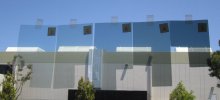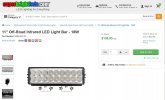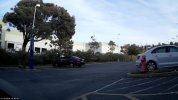@Radius8, thinking about this question a little further, using a calibration color chart
could work but you would likely need to re-focus the lens so you could fill the frame with the color chart
only (hopefully without too much barrel distortion) and you would need a consistent, diffused, 5000º K light source to illuminate the chart for each incremental color adjustment until you achieve the desired results.
So, I decided to try out my own suggestion about using a diffused 5000º Kelvin light source to do the color corrections for these non IR corrected lenses using a calibrated color chart as suggested by
@Radius8 and it turns out that it won't work with artificial lighting! And now that I've tried this and see the results it should have been obvious to me that it wouldn't have worked long before I started but I didn't think it through all the way. I was thinking in terms of how I usually go about calibrating my set-up when I have to photograph something that requires absolute color accuracy, such as photographing art work for publication. But under those circumstances there are generally no IR concerns in the lighting equation.
5000 degrees Kelvin is approximately the color temperature of noonday sunlight and is therefore used as the de facto standard for artificial "Daylight" illumination. It is commonly used in photography and video for image capture and as the standard illumination for viewing prints, negatives and in the four color printing industry for evaluating press output matched to Pantone
™ color chips. Electronic flash on typical cameras and studio strobe lighting is also 5000º K.
Basically though, artificial 5000º K lighting has virtually none of the IR wavelength component that natural daylight does, so with or without an IR-cut filter on your camera it seems you'll get
nearly the same results.
OK, so here's what I did and the results I got:
Firstly, I was inspired to try this in the first place because I just happened to have a 100 Watt 5000º K Daylight LED light bulb sitting right here in my office and it was just a matter of installing it in the architect's task lamp on my desk and pointing it at the calibration card I propped up against my second computer monitor. That made the experiment easy to do without spending too much time or effort on it in the middle of a busy day. While an LED household light bulb rated at 5000 K is not likely quite as accurate as professional studio lighting or a print shop light box it works fine for a simple test like this.
After setting up the lighting I then focused a Mobius on an 8x11 inch calibrated color rendition chart from about a foot away using the 6mm ƒ/1.2 lenses I have on hand since thanks to Treeye at AliExpress I just happen to have two identical ones, one with an IR-cut filter installed and one without an IR filter. Normally I would go about something like this with the camera on a tripod for careful aiming and alignment but in this case I just eyeballed it for lack of time knowing it would still give me the basic results I was looking for. I also didn't get too fussy about perfect focus because this too wouldn't have a huge effect on the results. This was all just a quick casual test to see what would happen.
OK, so here is the color calibration card shot with the 6mm ƒ/1.2 lens
WITH an IR-cut filter under 5000º K lighting. Color balance looks pretty good, as expected.
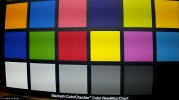
Here we have a screen shot using the other 6mm ƒ/1.2 lens
WITHOUT the IR-cut filter under natural North daylight filtering in through a nearby window. As expected, the image has an overall magenta color cast as would be expected from a lens with no IR-cut filter captured with a CMOS sensor.
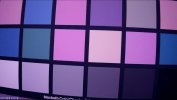
Here's where things get more interesting. Here is a shot made with the same non-corrected 6mm ƒ/1.2 lens
WITHOUT the IR-cut filter but under the 5000º K LED lighting.
Color balance here is more or less accurate with no IR filter with the exception of subtle shifts in the RED portion of the spectrum. Note in particular the RED color chip which is WAY off compared with the same chip above which is quite close to the actual color on the chart. From the looks of things there is "some" stray IR light coming from this bulb but most of the IR wavelengths that may be coming from the bare LED emitter are being filtered out resulting is a relatively good color balance without an IR-cut filter on the lens!
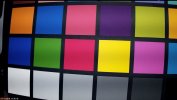
Here is the 5000º K Daylight LED light bulb I used that made this test so easy to carry out.
I don't know how this experiment might be effected by the use of a different type of 5000º K lighting source but I do happen to have a light table that uses 5000º K corrected fluorescent bulbs and may do a test just to see what happens. Then again, fluorescent lighting (of any color temperature) and CMOS chips are not a marriage made in heaven because of PWM so I don't know how that might effect color balance.

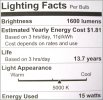
Conclusion:
So, it looks like you could indeed use a calibration card to adjust the color balance from a non-IR corrected lens if you get close enough to the card but you will need to do so under natural daylight.
The best approach would be North light filtering in through an appropriate window or outdoors in the bright shadow of a building on a sunny day. Avoid shooting test footage under direct sunlight; it will skew your results and ultimately damage the pigments in an expensive color calibration chart.
The goal here is to try for consistency of the lighting between adjustments as best as you can achieve.


